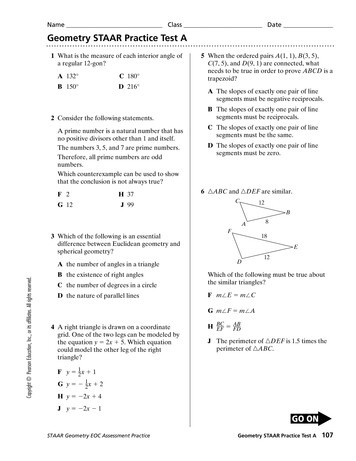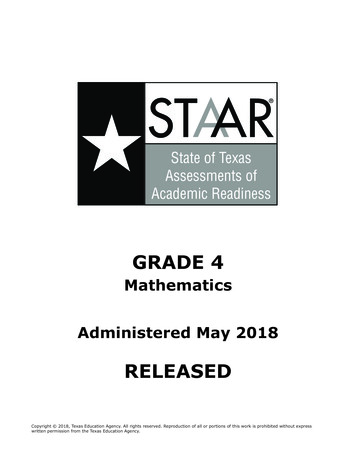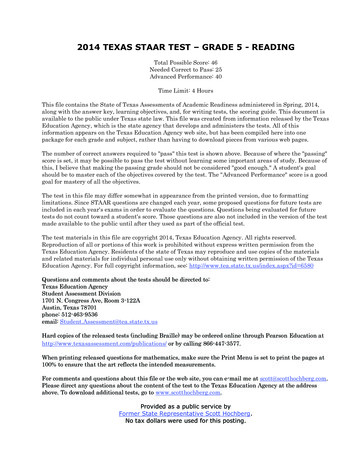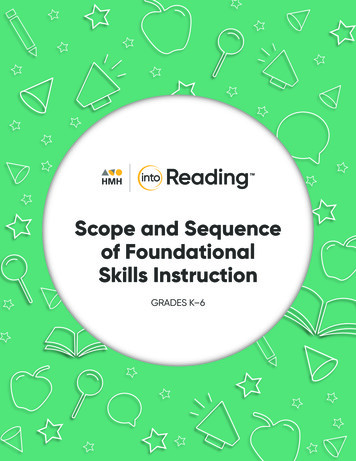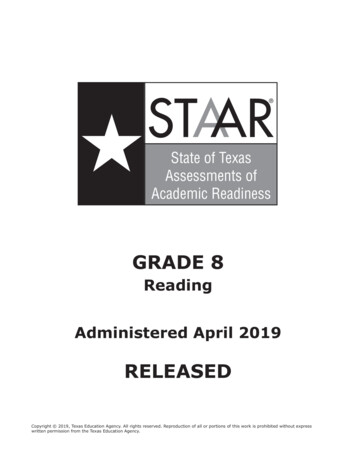
Transcription
STAAR State of TexasAssessments ofAcademic ReadinessGRADE 8ReadingAdministered April 2019RELEASEDCopyright 2019, Texas Education Agency. All rights reserved. Reproduction of all or portions of this work is prohibited without expresswritten permission from the Texas Education Agency.
READINGReadingPage 3
Read the selection and choose the best answer to each question. Then fill inthe answer on your answer document.A Rite of Passage (and theImportance of Penguin Etiquette)by Chris Epting1There’s a common expression, “No pain, no gain,” which means thatachievement requires some sort of sacrifice—mental sacrifice, physicalsacrifice—something. Little did I know how important that phrase would soonbecome in my life, all because of an invitation to witness, up close and personal,some of the most fascinating (and loveable) animals on this planet.2When my fourteen-year-old daughter, Claire, and I found out that we weregoing to Antarctica to visit with and study the emperor penguins, we werethrilled. We had entered and won an essay contest. The grand prize promised analmost unfathomable adventure: three weeks living aboard a Russian icebreakership near an icy, remote outpost called Snow Hill Island.3Getting to Antarctica is no small feat. It isextremely difficult to fly there, as the officialpopulation is zero. The few who are luckyenough to visit this most mysterious continentdo so by ships.4ReadingPage 4This is where the “pain” comes in. Yousee, to reach Antarctica, ships must passthrough a notoriously violent area of oceancalled the Drake Passage, considered to be theroughest stretch of sea on the planet.AtlanticOceanSouthAmericaNWESgee PassaDrak5Walls of water thirty, sometimes forty feetPacificAntarcticahigh—tremendous towers of dark green, icyOceanwaves—continually crashed about our ship fortwo solid days. We would hold on to a railing inside the ship while being violentlytilted to one extreme side, then to the other, and then back again. Over andover and over, nonstop. If not for the belt straps on our cabin bed, we wouldhave flown up in the air as we tried to sleep.6My daughter and I knew about the Drake Passage and were as mentallyprepared as we could be. We knew what waited at the end of the journey—thepenguins—and so together we convinced ourselves it was all worth the pain. Butas mentally prepared as we were, we also had to be physically aware, as well. Itwas important to always watch our footing as we crept to the dining room eachday to carefully grab a quick meal before returning to our cabin to ride out thesickening, never-ending storm.7I started to wonder, “Is this worth it? Will the gain be worth all of thisstruggle?”
8Then, about two and a half days after entering the Drake Passage, thewaters calmed. For the first time on our journey, we walked out on deck and feltthe sweet bite of the cold, clean air on our faces.9Soon, we noticed small black specks on nearby pieces of floating ice.Emperor penguins! The closer our ship got, the more it seemed as if the animalswere welcoming us—some of them actually beating their wings together, as ifthey were applauding our arrival.10Before long, we reached our final destination, and we were allowed to takeour first ice walk. Across the crunchy surface, we could see hundreds ofpenguins in the distance, watching us as we watched them.11As we learned on board, their interest was to be expected. Penguins areextremely curious and not fearful of humans.12The next day, two helicopters that would take us from our ship to the basecamp were assembled on the deck of the ship.13After landing, we were given instructions on “penguin etiquette.” Thesewere the basic rules: You can’t touch a penguin, but they can touch you if they’dlike. You can’t crowd them, but they can crowd you if they so desire. And youalways give them the right of way. Beyond those rules, we were free to explore,photograph, and observe to our heart’s content.14We began the two-mile hike over the ice to the penguin colony.15Within several hundred yards, little clusters of emperors, perhaps ten or soat a time, greeted us, sliding on their bellies and making their wonderful noises,sort of a nasally squeal. But the real treat still awaited: the colony.16As far as we could see, there were emperor penguins—tens of thousands ofthem, stretched out to the horizon line. It was breathtaking. Thousands of newlyhatched chicks waddled among the adults, vying for attention.ReadingPage 5
Jonathan & Angela Scott/Getty ImagesA Colony of Emperor Penguinsat Snow Hill IslandWe found a quiet piece of ice, sat down, and within minutes weresurrounded by dozens of curious emperors. In some cases, their beaks were justinches from our noses.18One day, two adult emperors with their three chicks in tow approachedClaire, who was resting on the ice. They left the chicks with her, as if she werethe babysitter. Twenty minutes later they returned to collect the chicks. And Iwill never forget the penguin that, when I jokingly asked which way back to thehelicopters, pointed a wing in the correct direction.Emperor Penguin ChicksFrank Krahmer1719Every night aboard our safe and warm ship, we thought about what it takesto survive in Antarctica, an incredibly harsh place.20But each day on the ice, we also thought about the Drake passage, thatmonstrous body of water we had to endure to get where we were. Over thecourse of our visit, we came to respect and even revere the power of that sea.ReadingPage 6
2122We still talk about the penguins, as I’m sure we always will. But we talkabout the Drake too. Both experiences were unforgettable, and one would nothave been possible without the other.No pain, no gain.From Breakfast on Mars and 37 Other Delectable Essays: Your Favorite Authors Take a Stab at the Dreaded EssayAssignment 2013 edited by Rebecca Stern and Brad Wolfe. Reprinted by permission of Roaring Brook Press, a divisionof Holtzbrinck Publishing Holdings Limited Partnership. All rights reserved.ReadingPage 7
1 When describing the penguins, the author mostly focuses on their —Aconcern for their baby chicksBfriendly and entertaining behaviorCability to survive in their environmentD dependence on one another2 In paragraph 4, what does the word notoriously mean?FFrequently traveledG Hard to locateH Recognized in a negative wayJViewed from a distance3 Which sentence from the selection best conveys the author’s main message?ABut as mentally prepared as we were, we also had to be physically aware, as well.(paragraph 6)BEvery night aboard our safe and warm ship, we thought about what it takes to survive inAntarctica, an incredibly harsh place. (paragraph 19)COver the course of our visit, we came to respect and even revere the power of that sea.(paragraph 20)D Both experiences were unforgettable, and one would not have been possible without theother. (paragraph 21)ReadingPage 8
4 The organizers of the expedition created “penguin etiquette” most likely to —Flimit the interaction between the penguins and the visitorsG minimize possible negative effects of visitors on the penguin habitatH create awareness among the visitors about the challenges penguins faceJboost visitors’ chances of observing tens of thousands of penguins each day5 Based on the selection, what did the author most likely gain from his experience?AAn understanding of how animals survive in cold climatesBAn interest in other journeys that involve physical challengesCAn awareness of the types of activities his daughter enjoysD An increased respect for the power of nature6 What is the best summary of this selection?FWhen the author and his daughter win a trip to Antarctica, they board an icebreaker shipand travel through an area called the Drake Passage. During their time in Antarctica, theyobserve a penguin colony made up of tens of thousands of penguins. They must adhere tocertain rules while they are there.G Getting to Antarctica requires people to travel by ship through a rough area of the sea.After winning a trip to Antarctica to observe penguins, the author and his daughter makethis difficult voyage. Once they arrive, they see thousands of penguins up close and knowthe trip was worth the suffering.H The author and his daughter take a trip to Antarctica, where they have an opportunity toobserve penguin behavior up close. They take photographs of the large penguin colony.Long after the trip, they still talk about the experience.JReadingPage 9After winning a contest, the author and his daughter travel to Antarctica and seepenguins. Since there are no airports in Antarctica, they have to sail there through roughwater. Once they arrive, they must take a helicopter from their ship over to the penguincolony.
7 Which sentence from the selection best expresses the author’s enthusiasm during hisobservation of the penguins?AAcross the crunchy surface, we could see hundreds of penguins in the distance, watchingus as we watched them. (paragraph 10)BPenguins are extremely curious and not fearful of humans. (paragraph 11)CWe began the two-mile hike over the ice to the penguin colony. (paragraph 14)D And I will never forget the penguin that, when I jokingly asked which way back to thehelicopters, pointed a wing in the correct direction. (paragraph 18)8 Read this sentence from paragraph 8.For the first time on our journey, we walkedout on deck and felt the sweet bite of the cold,clean air on our faces.The sensory language in this sentence best reveals the author’s —Fsense of relief and accomplishment at having arrived in AntarcticaG understanding of the extreme weather conditions in AntarcticaH frustration at having been kept in his cabin for most of the voyageJfeeling of anticipation to soon be interacting with the penguinsReadingPage 10
Read the next two selections. Then choose the best answer to eachquestion.1Yellowstone National Park extends across aunique area of land in Wyoming, Montana, andIdaho. Thousands of geothermal vents that liejust below the earth’s surface cover this vastregion. Geothermal vents are deep holes in theground that release built-up pressure in theform of steam and scalding-hot water. Thetemperature of the ground near these hotspots can rise to more than 150 degreesFahrenheit. During a trip to Yellowstone,microbiologist Rusty Rodriguez noticedsomething peculiar. He observed many plantsthriving in the searing soil despite theseintense conditions. Rodriguez wondered howthese plants were able to flourish in suchextreme temperatures while other plants insimilar or milder environments perish.2To solve this mystery Rodriguez took plantsamples back to his laboratory forA Geothermal Vent atinvestigation. Under a microscope he saw tinyYellowstone National Parkstrands of fungi called endophytes living on theplants. Rodriguez’s research revealed that theendophytes made the plants better able to handle climate stressors such asdrought, heat, and cold. Correspondingly, the plant provided sugar to supportthe existence of the fungi.3About 80 percent of the earth’s plants have a strain of endophyte fungus livingon them. However, in the last few decades the fungi have unintentionally beendestroyed by pesticides and fertilizer. Rodriguez believed that if the fungi couldsomehow be added back to a plant, its natural protection could be restored.4Rodriguez extracted endophyte fungi from several native plants known forsurviving extreme temperatures to create a mixture. He found that when themixture is applied to seeds, plants become immune to many of the agriculturalwoes that plague farmers. When plants are restored with endophyte fungi, theyare protected from heat or cold. They also require less water and fertilizer togrow. Overall, plants are much healthier and more resilient.ReadingPage 11 iStock.com/SBTheGreenManPersevering Plants
Used with permission.Both of these soy plants experienced six daysof drought conditions, but the one on the rightwas treated with Rodriguez’s endophyte mixture.5Rodriguez has tested his endophyte mixture on crops and achieved success. In2012 the state of Michigan was experiencing severe drought and extremetemperatures. Corn and rice seeds were coated with Rodriguez’s creation to seehow they would endure such conditions. The results were overwhelminglyoptimistic. Crop yields increased by 85 percent. In addition, the plants usedbetween 25 and 50 percent less water than those not treated. Simply put,plants that had the mixture added to them were more inclined to toleratedrought than others.6Scientists are hopeful about the potential of endophyte fungi. Plants are easilyprotected from drought and other severe conditions when they are treated withthis fungus. It is also a natural, nontoxic substance that does not harm plants orhumans. Endophyte fungi could quite possibly be the key to providingsustainable crops for the future.Third party trademark Yellowstone was used in these testing materials.ReadingPage 12
Smart Discoveries in ScienceIn this issue: The Cure for ConcreteSeptember 2015The Cure for ConcreteBacteria have a reputation for being harmful. However, not all bacteria are bad.Some food products, such as yogurt, contain good bacteria. The human bodyeven stores bacteria that help us produce vitamins and fight diseases.2Dutch microbiologist Hendrik Jonkers studies bacteria. He also has researchedhow certain living organisms are able to heal themselves when injured. Anoctopus, for example, can grow a new arm if needed. When a bone breaks inthe human body, it is able to repair itself. Jonkers wondered if bacteria could beused to “heal” nonliving substances in a similar way. He tested this theory byadding bacteria to concrete. He discovered that concrete may also be able torecuperate from damage.3Concrete is one of the most important building materials. It was even used bythe ancient Romans to build massive structures such as the Colosseum. Today itis used to construct highways, bridges, and high-rise buildings. In fact, concretedemand has doubled in the last decade. Concrete production now accounts for5% of the world’s carbon emissions, which is harmful to the environment.The Colosseum in Rome, Italy, isalmost 2,000 years old.4ReadingPage 13 Nataliya Hora/Dreamstime.com1Despite its popularity, concrete cracks. When water gets inside the cracks, itweakens the composition of the concrete. Eventually the concrete must berepaired or replaced. In Europe the annual cost of maintaining concretestructures is billions of dollars.
Jonkers has developed a self-healing concrete, or bioconcrete, to help solvethese problems. He combines concrete with bacteria that are naturally able toproduce limestone, a hard rock. The bacteria are placed inside plastic capsulesthat are mixed into wet concrete. The bacteria can live in the hardened concretefor decades. When water enters through cracks in the concrete, the plasticcapsules open, and the bacteria are released. As the bacteria grow and multiply,they form limestone, which fills in the cracks.Hendrik Jonkers with a Slab of BioconcreteDelft University of Technology56In 2011 self-healing concrete was used to construct a lifeguard station near alake in the Netherlands. Lifeguard stations are susceptible to damage by waterand weather. With the help of Jonkers’ bioconcrete, the lifeguard station hasremained intact. Bioconcrete has been used on the floors and roofs of parkinggarages. It has even been used to reconstruct a canal and irrigation system inEcuador.7While bioconcrete has its advantages, it is 50 percent more costly to create thantraditional concrete. This makes the product unappealing to some people in theconstruction industry. Still, Jonkers believes the initial investment is worth thelong-term savings and advantages it will provide.8Bioconcrete will reduce the need for repairs and making new concrete. In return,this will help manufacturers save money over time, and it will help lessen theamount of carbon pollution. Jonkers says, “I think it’s a really nice example oftying nature and the built environments together in one new concept.”ReadingPage 14
Use “Persevering Plants” (pp. 11–12) to answer questions 9–13. Then fillin the answers on your answer document.9 Which characteristic of the geothermal vents made the survival of nearby plants sosurprising?AThe depth of the holesBThe heat they generateCThe number of them that existD The amount of pressure they release10 How do the photograph and caption after paragraph 4 help the reader better understand theselection?FThey explain how endophytes work to help plants.G They demonstrate the effect endophytes can have on plants.H They illustrate what kinds of plants endophytes can help.JThey show the conditions against which endophytes can protect plants.11 How are paragraphs 2 through 4 organized?AThey compare the plants Rodriguez collected to the endophytes living on the plants.BThey describe the steps Rodriguez followed while researching plants in his laboratory.CThey explain the problem Rodriguez was trying to solve based on his observations.D They describe the structure of the plants Rodriguez collected from a harsh environment.ReadingPage 15
12 What is paragraph 1 mostly about?FThe unusual conditions in which some plants can surviveG The occurrence of geothermal vents in several western statesH The way geothermal vents release pressure in the form of steamJThe types of plants that microbiologists have observed at a national park13 An idea emphasized throughout the selection is that Rodriguez’s endophyte solution —Acan improve plant life in national parksBeliminates the need to water plants regularlyCwill allow farmers to plant crops regardless of the seasonD can restore a plant’s natural resistance to the effects of a harsh climateReadingPage 16
Use “The Cure for Concrete” (pp. 13–14) to answer questions 14–18. Thenfill in the answers on your answer document.14 Which statement best expresses the main idea of paragraph 3?FModern highways and bridges are often constructed with concrete.G Concrete was used by ancient Romans to build massive structures.H The demand for concrete has doubled in the last decade.JConcrete has been and continues to be an important building material.15 The information in paragraph 6 helps the reader understand that bioconcrete —Aworks best in areas affected by harsh weather conditionsBis effective in repairing water damageChas a maximum weight that it can supportD is limited to use in certain parts of the world16 How does the author organize paragraph 1?FBy listing types of bacteria and then telling how they help fight diseases in thehuman bodyG By defining bacteria and then explaining how bacteria are used in some productsH By stating a popular belief about bacteria and then disproving it with examplesJBy comparing good and bad bacteria and then describing how bacteria workReadingPage 17
17 What is the best summary of the article?AConcrete is a popular material, but it can develop cracks over time. Microbiologist HendrikJonkers believes that adding bacteria to concrete can help remedy this problem andprovide savings for the construction industry.BHendrik Jonkers, a Dutch microbiologist, noticed that concrete cracks over time. Hedecided to add bacteria to concrete to make a substance called bioconcrete. The bacteriaare placed inside plastic capsules that are mixed into wet concrete.CA Dutch microbiologist named Hendrik Jonkers became interested in investigating howbacteria might be applied to concrete to fill cracks in concrete caused by water. Hedeveloped a self-healing bioconcrete that works to make concrete more durable.D Microbiologist Hendrik Jonkers wondered if concrete could repair itself in the same waythat human bones do. He developed bioconcrete, which was used to build a lifeguardstation near a lake in the Netherlands and repair an irrigation system in Ecuador.18 Read this sentence from paragraph 2.When a bone breaks in the human body, it isable to repair itself.What is the most likely reason the author includes this information?FTo advocate for more research concerning skeletal injuriesG To suggest that bacteria could improve people’s healthH To show the need for Jonkers’ researchJTo provide an example of the goal of Jonkers’ researchReadingPage 18
Use “Persevering Plants” and “The Cure for Concrete” to answerquestions 19–22. Then fill in the answers on your answer document.19 What is one way that Rodriguez’s and Jonkers’ methods were similar?AThey both created mixtures using living materials.BThey both traveled to an unfamiliar location to begin their research.CThey both studied particular animals to inform their research.D They both considered how temperature might affect their results.20 Read this sentence from paragraph 5 of “Persevering Plants.”Rodriguez has tested his endophyte mixture oncrops and achieved success.Which sentence from “The Cure for Concrete” shows a similar outcome for bioconcrete?FThe bacteria can live in the hardened concrete for decades. (paragraph 5)G In 2011 self-healing concrete was used to construct a lifeguard station near a lake in theNetherlands. (paragraph 6)H With the help of Jonkers’ bioconcrete, the lifeguard station has remained intact.(paragraph 6)JBioconcrete has been used on the floors and roofs of parking garages. (paragraph 6)ReadingPage 19
21 What is one problem presented about bioconcrete that is not presented about endophytefungi?ABioconcrete is expensive to produce.BBioconcrete may be unintentionally destroyed.CBioconcrete contains harmful bacteria.D Bioconcrete is exposed to weather conditions.22 What is one difference between Rodriguez’s endophyte mixture and the bacteria in Jonkers’products?FThe endophyte mixture is clearly visible on seeds.However, the bacteria in the concrete cannot be detected.G The endophyte mixture covers the outside of seeds.However, the bacteria are placed inside the concrete.H The endophyte mixture is not a substance found naturally in plants.However, the bacteria is a natural part of concrete.JThe endophyte mixture remains inactive for a period of time.However, the bacteria begin to work immediately.ReadingPage 20
Read the selection and choose the best answer to each question. Then fill inthe answer on your answer document.invitationby Mackenzie Connelleeused to write poetry in art classwhen the teacher wasn’t looking,but now i don’t take art and i can’tafford not to pay attention in my5 classes. now i write poetry in myfree time but that’s difficultbecause words don’t appear like10152025a dog when you call their name, no,poetry is anything but convenient.right now it’s 1:05 A.M. because poetryshook me by the shoulders and saidhey, this is important but now i’m wonderingif the lack of sleep is worth it. i feeli am always weighing time by the qualityof poems written, because even whenthe words grace me with their presence,they don’t always choose to stepdelicately into the world, pink shoestreading softly over the white horizon.usually poetry slops lazily over the couchof a page and dangles while i remove its muddyshoes and rearrange the pillows, all the whilemuttering something about Frost and how maybehis comments against free verse were rightall along (poetry in rhyme always cleans upafter itself) although honestly, you haven’t liveduntil the homeless free-verse poem on your couchdecides to stay for a cup of tea and, if you’relucky, lets you take notes on everything he says.Courtesy of Mackenzie ConnelleeReadingPage 21
23 Which of these ideas is emphasized by the simile in lines 7 and 8?APoetry can appear in many different forms.BNew poems can be valued like a companion.CNew poems do not come to mind right away.D Poetry writing is not as enjoyable as having a pet.24 Read the dictionary entry.afford \Ǩ-Ɏfȯrd\ v1. to bear the financial cost of 2. tobe able to spare or give up 3. toprovide for another 4. to be thecause or source ofWhich definition best matches the way the word afford is used in line 4?FDefinition 1G Definition 2H Definition 3JDefinition 425 What process is the poet describing when she uses the words “i remove its muddy shoes andrearrange the pillows” in lines 21 and 22?AFinding a topic to write aboutBWriting from personal experienceCRevising a poem’s ideas and wordsD Sharing a poem with an audienceReadingPage 22
26 The title of the poem is effective because it suggests that the speaker —Fdesires more poetry to come into her lifeG tries to schedule time for writing poetryH longs for poetry assignments at schoolJwants people to enjoy reading her poetry27 What do the contrasting images in lines 17 through 22 suggest?AWriting poetry can be relaxing.BPoets are sensitive by nature.CWriting poetry is often not easy.D Poets have active imaginations.28 The poet uses lines 1 through 6 to establish that —Fart and poetry share many similaritiesG the speaker hopes to keep her poetry a secretH poetry is an important subject to learn in schoolJthe speaker wishes she had more time to write poetryReadingPage 23
Read the selection and choose the best answer to each question. Then fill inthe answer on your answer document.1The typical person is bombarded by hundreds of logos each day. We see themon signs, vehicles, television, and even on the clothes we wear. Logos aredistinct images used to represent brands. There are logos such as the famousNike “swoosh,” the colorful rings to identify the Olympic Games, and the UnitedStates Postal Service eagle emblem, just to name a few. All of these logos aredesigned to attract our attention. They also help us remember a product orservice connected to that image. However, research conducted at the Universityof California at Los Angeles (UCLA) supports the idea that remembering what alogo looks like is a very difficult task.2In 2015 researchers at UCLA gave 85 students asimple assignment. They had to draw the Apple logopurely from memory. Most of the students wereApple users, so they had the opportunity to look atthe logo every day. Surprisingly, only one student inthe study could accurately draw the logo frommemory. Many of the sketches the other studentsmade were flawed. Some of them drew the basicsright but missed minor details of the design—no biteout of the apple or the wrong number of leaves. Atfirst the researchers thought the problem might beThe Apple Logothat the students were just not very good at drawing.They decided to ask the students to look at several different images and choosethe logo that was most accurate. Less than half of the students could detect thecorrect image.3The UCLA Apple study is not the first time our ability to remember the details ofimages has been tested. In the 1970s researchers asked a group of people todraw a penny from memory. Participants were instructed to show the imagesand words just as they appear on the coin. Like the Apple study, most peoplecould not precisely depict the image. Participants were unable to correctlyidentify which way Lincoln was facing or where the word “Liberty” was placed onthe coin. While the penny is not technically a logo, it is an object with whichpeople have frequent interaction. So why is it so difficult for people to recall thedetails of images, such as logos, that they see every day? Researchers havedeveloped a theory they think might help to explain this blind spot in ourmemories.ReadingPage 24 Subhra2jyoti/Dreamstime.comWhat Can We See in a Logo?
Kevin Grant/Dreamstime.comTwo Sides of a Penny4Logos are typically designed to be simple and easy to recognize with a quickglance. Yet the frequent exposure to these logos can actually make our brainsoverlook them. This process is known as “attentional saturation.” It would bechallenging to try to remember every single thing that crosses our path. Wetake in so much information every day that the brain works to spot informationthat does not need to be stored. It allows this unimportant information to fadefrom our memory. Our brains actually signal us to ignore information we do notthink we will need to remember.5The details of product logos are just the kind of information our brains tell us wedo not need. This may be discouraging to logo designers and to companies thatuse these eye-catching logos. But there are still many business experts whobelieve in the importance of a recognizable logo.6Even though the brain is accustomed to ignoring unnecessary details, it is alsoprogrammed for recognition. When we see images such as logos over and overagain, we become familiar with them. This constant exposure leads tosomething scientists refer to as gist memory. “Gist memory” means that ourbrain remembers the basic idea without all of the details. This general sense ofmemory has its own benefits. When we see that “swoosh” or the apple with abite out of it, we are acquainted with the image. We may not be able to draw aperfect outline of the logo, but we are able to recognize the image. When peopleare able to recognize an image, it can make them feel like they really know theproduct behind the logo. In fact, familiarity with a prevalent logo can even makepeople feel more comfortable about purchasing or using certain products.7Logos are everywhere we look today. A fancy design or a thoughtful colorcombination may be a good start for a logo concept, but there are other factorsto consider. Those establishing a logo need to know that people will onlyremember what they believe is worthwhile. A clever design may be interesting,but most people will forget the details—especially if our brains have anything tosay about it.Third party trademarks Nike , swoosh , Olympic , United States Postal Service , University of California LosAngeles , UCLA and Apple were used in these testing materials.ReadingPage 25
29 “Gist memory” occurs when the brain —Arecalls specific detailsBremembers a general ideaCconnects informationD overlooks common images30 In paragraph 6, the word prevalent means —FelaborateG creativeH vitalJwidespread31 What exam
e D r a k P a s a g e . South America . Atlantic Ocean. N W E S . Pacific. Antarctica . Ocean 1. Read t
